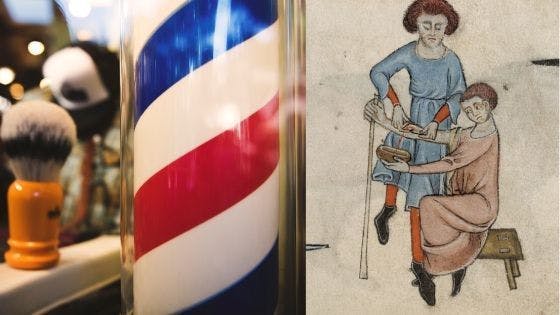The Shocking (and Bloody) History of the Barber Pole

Everyone is familiar with the iconic red, white, and blue pole that hangs outside of barbershops, but few people know the surprising (and graphic) story of how it came to be.
In order to understand the history of barber poles, you first have to know a little bit about the history of barbers.
Barbers in Ancient Times
The trade of barbering has a long and fascinating history, and for most of that history being a barber meant a lot more than cutting hair.
In Ancient Egypt, for example, barbers would shave the pharaohs and their families to denote their believed distinction from the rest of the Egyptian people.
Barbering was important in many other ancient cultures for marking people as being part of different levels of society. The practice was even found in the ancient Mongolian and Viking cultures.
But it was not until the Middle Ages that we see the emergence of the cultural trends that would eventually lead to the present-day barber pole.
Barbers in Medieval Times (aka Barber Surgeons)
In the Middle Ages barbers had also become surgeons.
In Medieval Europe, hair grooming was only one of many services provided by barbers, who were then called "barber surgeons." Barber surgeons also performed procedures such as leaching, blood-letting, amputations, and tooth extractions.
Why Barbers Became Surgeons
Prior to the rise of barber surgeons, surgeries and minor medical procedures were often performed by Catholic monks.
But monks were prohibited from performing any such procedures by Pope Alexander III in 1163, who decided that these procedures were not part of the role that a monk should have in society.
And while Pope Alexander III saw the minor surgical tasks as incompatible with the clergy, professional physicians saw them as too menial for them to perform.
This created a hole in the market that barbers--who already had lots of blades--were well positioned to fill.
Thus, the barber surgeon was born.
The Bloodletting Pole
The most common health remedy provided by barber surgeons was bloodletting. Bloodletting is exactly what it sounds like--the draining of blood from the patient--and was done to release "bad humours"
It was believed that draining blood would both rebalance "the humors" of the patient and encourage new healthy blood to be made by the body.
It was a common treatment for all kinds of ailments, from head aches to rashes.
During this common procedure, barber surgeons would have patients squeeze a pole, which served both to expose veins for cutting, and increase the blood flow once they were cut.
To advertise this service barber surgeons began to hang the blood-stained pole (or a replica of it) outside their shops.
The Pole Develops Further
Fast foward to London in 1540 and the barbers, who had organized themselves as the Worshipful Company of Barbers, joined together with the Fellowship of Surgeons to form what would be called the Company of Barber and Surgeons.
This was the coat of arms for the Worshipful Company of Barbers:
The Company of Barbers and Surgeons decided to give each trade a distinct pole which which to advertise their services.
Barbers would be marked by a white pole with blue stripes.
Surgeons would be marked by a white pole with red stripes.
This setup lasted until 1745 when the surgeons broke away from the barbers to form the Royal College of Surgeons and abandoned the pole identification system altogether.
In the years that followed, barbers would eventually combine the blue and red stripes into the modern barber pole that we see today.
Today, barber poles are found outside of all barber shops in the United States and barbers take great pride in the symbol of their trade.
Fun fact: There are even laws governing who is allowed to have a barber pole and who is not.
Now you know the story of the barber pole!



